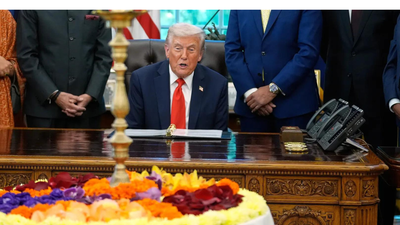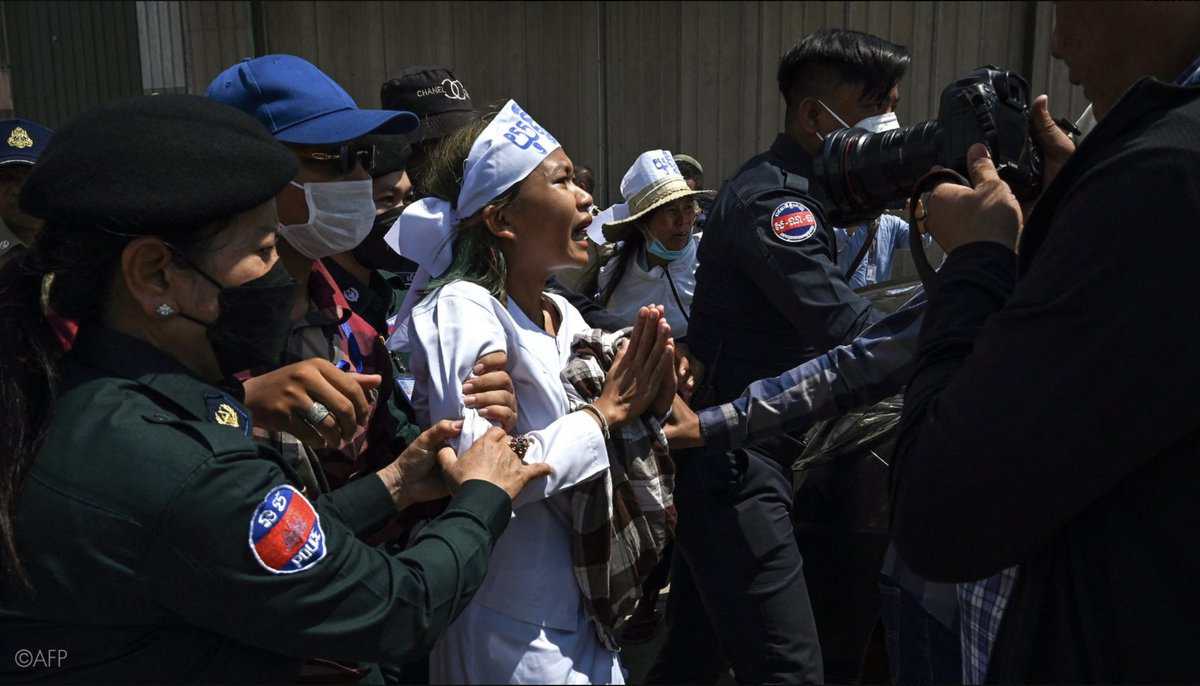Report on Social Cohesion and Sustainable Development Challenges Following White House Diwali Celebration
Executive Summary
A Diwali celebration hosted at the White House by President Donald Trump on Tuesday, October 21, 2025, prompted a significant nativist backlash on social media platforms. This reaction highlights profound challenges to achieving key Sustainable Development Goals (SDGs), particularly SDG 10 (Reduced Inequalities) and SDG 16 (Peace, Justice and Strong Institutions). The incident underscores deep societal divisions, racial and religious intolerance, and the erosion of social cohesion, which threaten the principles of inclusive development and peaceful societies.
Analysis of Event and Subsequent Reaction
Event Overview
President Donald Trump continued a bipartisan tradition, initiated in 2003, by hosting a Diwali lamp-lighting ceremony in the Oval Office. The event was attended by approximately two dozen prominent Indian-Americans, including:
- Corporate Leaders:
- Arvind Krishna (IBM)
- Sanjay Mehrotra (Micron Technology)
- Shantanu Narayen (Adobe Systems)
- Nikesh Arora (Palo Alto Networks)
- Administration Officials:
- Kash Patel (FBI Director)
- Tulsi Gabbard (National Intelligence czar)
- Harmeet Dhillon (Justice Department’s Civil Rights head)
- Sriram Krishnan (White House policy Advisor on AI)
During the ceremony, President Trump praised the Indian-American community for its cultural and economic contributions, acknowledging the attendees as “the biggest business people in the world.”
Nativist Backlash
Following the event, scores of supporters from the MAGA movement, including self-identified Christian nationalists, expressed outrage on social media. The response was characterized by xenophobic, racist, and religiously intolerant rhetoric. Comments described the Hindu ritual as “pagan” and “demon worship,” and portrayed Indian-Americans as “job stealers” and “unassimilable foreigners.” Prominent figures such as Nick Fuentes amplified this sentiment, criticizing the President for engaging with the Indian-American community.
Implications for Sustainable Development Goals (SDGs)
SDG 10: Reduced Inequalities
The incident reveals significant obstacles to the achievement of SDG 10, which aims to reduce inequality within and among countries.
- Target 10.2 – Promote Social and Political Inclusion: The hostile reaction directly contravenes the goal of including all people irrespective of origin, race, or religion. The rhetoric seeks to marginalize the Indian-American community, framing their cultural practices and economic success as a threat to national identity.
- Target 10.3 – Ensure Equal Opportunity: While the economic success of the Indian-American community is notable—with a median household income ($126,000) nearly double the national median ($69,000)—the backlash indicates that this success is met with resentment rather than being seen as a positive outcome of equal opportunity. This social friction undermines the very foundation of inclusive prosperity.
SDG 16: Peace, Justice and Strong Institutions
The backlash represents a direct threat to the promotion of peaceful and inclusive societies as outlined in SDG 16.
- Erosion of Social Cohesion: The event and its aftermath expose deep fractures in social cohesion. The proliferation of hate speech and discriminatory language online undermines the mutual respect and trust necessary for a peaceful society.
- Challenge to Inclusive Institutions: The criticism of a multicultural event at the highest level of government signals a rejection of inclusive institutions. The nativist calls for a nation recognizing only one religion are fundamentally at odds with the principles of justice and non-discriminatory policies (Target 16.b).
SDG 4 (Quality Education) and SDG 8 (Decent Work and Economic Growth)
The socio-economic data cited in the report links directly to education and economic growth, yet the reaction highlights a societal disconnect.
- Education Disparities (SDG 4): The article notes a significant educational gap, with nearly 80% of Indian-Americans holding college degrees compared to 36% of native-born Americans. This disparity appears to fuel resentment and isolationist sentiment, indicating a failure to achieve Target 4.7, which includes the promotion of global citizenship and appreciation of cultural diversity.
- Inclusive Economic Growth (SDG 8): The leadership of Indian-Americans in major technology and business sectors represents a significant contribution to economic growth and innovation. However, the perception of this group as “job stealers” by a segment of the population demonstrates that economic contributions alone are insufficient to ensure social inclusion. This disconnect poses a long-term risk to sustainable and equitable economic development.
Conclusion
The response to the White House Diwali celebration serves as a critical case study of the challenges facing the United States in advancing the 2030 Agenda for Sustainable Development. The incident illustrates that progress in economic and educational attainment by a minority group can trigger social and political backlash if not accompanied by robust efforts to foster cultural understanding, reduce inequality (SDG 10), and build peaceful, inclusive institutions (SDG 16). Addressing the root causes of this division, including educational disparities and the spread of discriminatory ideologies, is essential for achieving sustainable development for all members of society.
Analysis of Sustainable Development Goals (SDGs) in the Article
1. Which SDGs are addressed or connected to the issues highlighted in the article?
The article highlights issues of social division, discrimination, and inequality, which directly connect to several Sustainable Development Goals. The primary SDGs addressed are:
- SDG 10: Reduced Inequalities: The central theme of the article is the hostility and discrimination faced by an immigrant group (Indian-Americans) from nativist circles. It discusses disparities in social acceptance, income, and education, which are core concerns of SDG 10.
- SDG 16: Peace, Justice and Strong Institutions: The article describes a breakdown in social cohesion, characterized by “rage-posting,” racism, and religious intolerance (“The White House has been defiled by celebrating Diwali with a pagan ritual”). These elements undermine the goal of promoting peaceful and inclusive societies for sustainable development.
2. What specific targets under those SDGs can be identified based on the article’s content?
Based on the issues discussed, the following specific targets can be identified:
-
Under SDG 10 (Reduced Inequalities):
- Target 10.2: “By 2030, empower and promote the social, economic and political inclusion of all, irrespective of age, sex, disability, race, ethnicity, origin, religion or economic or other status.” The article shows a direct challenge to this target. The “almighty meltdown” and “hysteria” from MAGA fundamentalists against the Diwali celebration demonstrate a push against the social and religious inclusion of Indian-Americans.
- Target 10.3: “Ensure equal opportunity and reduce inequalities of outcome, including by eliminating discriminatory laws, policies and practices…” While the article doesn’t mention specific laws, it details discriminatory attitudes and practices, such as viewing Indian-Americans as “job stealers” and invoking stereotypes about “skin color, hygiene, caste, and religion.” These attitudes are precursors to discriminatory practices that create inequalities of outcome.
-
Under SDG 16 (Peace, Justice and Strong Institutions):
- Target 16.7: “Ensure responsive, inclusive, participatory and representative decision-making at all levels.” The backlash against the President for hosting a multicultural event like Diwali signifies a rejection of inclusive governance by a segment of the population, thereby challenging this target.
- Target 16.b: “Promote and enforce non-discriminatory laws and policies for sustainable development.” The article highlights prevalent discriminatory sentiments (“nativist flock which sees Indians and Indian-Americans as ‘job stealers’ or ‘unassimilable foreigners'”). The existence and public expression of such views work against the principles of non-discrimination that this target aims to promote.
3. Are there any indicators mentioned or implied in the article that can be used to measure progress towards the identified targets?
The article does not cite official SDG indicators, but it provides data and qualitative descriptions that can serve as proxies or direct measures for progress (or lack thereof) towards the identified targets.
- Indicators for SDG 10 (Reduced Inequalities):
- Income Disparity: The article explicitly states, “median household income of Indian-Americans is double that of white US-born Americans and the national median ($126,000 v $ 69,000).” This data serves as a direct indicator of economic inequality between different population groups.
- Educational Attainment Disparity: The text provides a clear metric: “Nearly 80 percent of Indians and Indian-Americans have college degrees compared to 36 percent for native-born Americans.” This highlights a significant gap in educational outcomes.
- Perception of Discrimination: The article implies the relevance of an indicator related to perceived discrimination (related to official indicator 10.3.1). The “flood of rage-posting,” racist comments (“The horrible optics of this are only surpassed by the horrible smell in there”), and accusations of “demon worship” are qualitative evidence of widespread discriminatory attitudes within a specific group.
- Indicators for SDG 16 (Peace, Justice and Strong Institutions):
- Prevalence of Hate Speech: The article’s description of social media posts from “MAGA fundamentalists” and a “raging racist platformed on Elon Musk’s X” serves as a qualitative indicator for the prevalence of hate speech and intolerance, which undermines a peaceful and inclusive society.
4. Table of SDGs, Targets, and Indicators
| SDGs | Targets | Indicators (Mentioned or Implied in the Article) |
|---|---|---|
| SDG 10: Reduced Inequalities |
10.2: Promote social, economic, and political inclusion of all, irrespective of origin or religion.
10.3: Ensure equal opportunity and reduce inequalities of outcome by eliminating discriminatory practices. |
– Disparity in median household income between Indian-Americans ($126,000) and white US-born Americans ($69,000). – Disparity in educational attainment: 80% of Indian-Americans have college degrees vs. 36% for native-born Americans. – Prevalence of discriminatory attitudes and stereotypes (e.g., “job stealers,” comments on skin color, hygiene, religion). |
| SDG 16: Peace, Justice and Strong Institutions |
16.7: Ensure responsive, inclusive, and representative decision-making.
16.b: Promote and enforce non-discriminatory policies. |
– Public expression of religious intolerance (e.g., calling Diwali a “pagan ritual” and “demon worship”). – Widespread online hate speech and “rage-posting” against an ethnic and religious group. – Rejection of inclusive, multicultural events at the governmental level by nativist groups. |
Source: timesofindia.indiatimes.com







